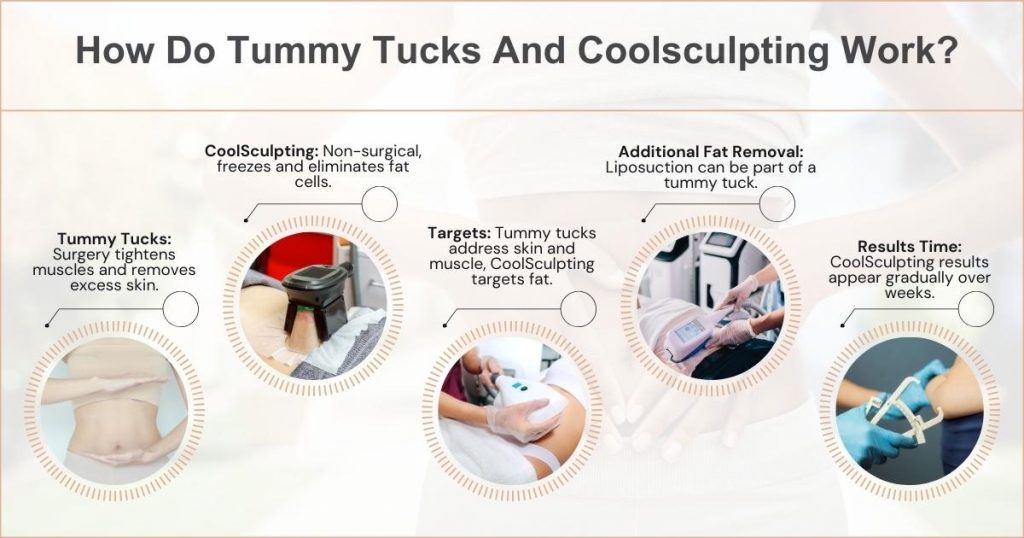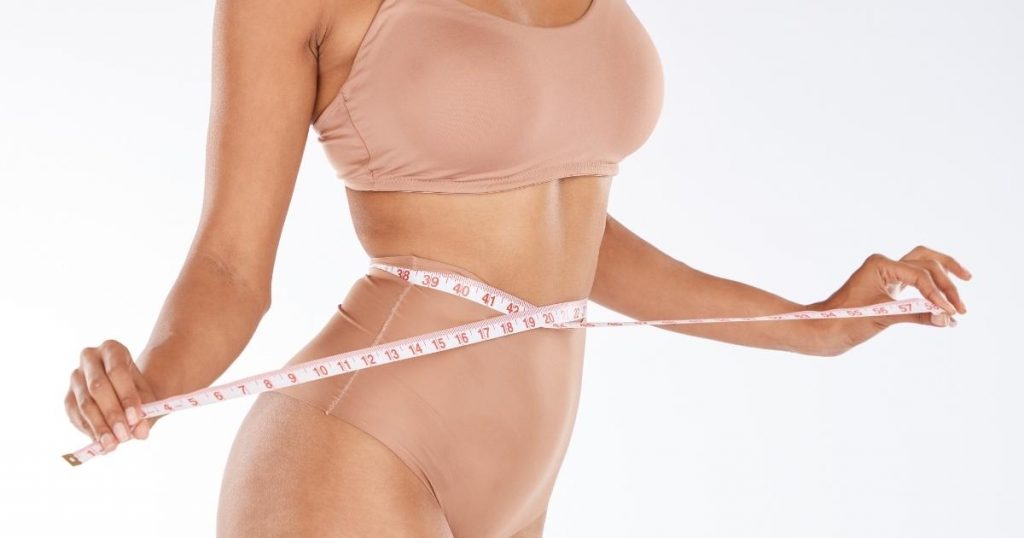Everyone wants to look their best. A flat tummy can help with that. But how do you get it? Two popular choices are the Tummy Tuck vs. Coolsculpting. This article will help you understand both so you can choose the right one.
What Is The Primary Difference Between A Tummy Tuck vs. Coolsculpting?
A tummy tuck is a surgical procedure that removes excess skin and fat from the abdominal area, while CoolSculpting is a non-surgical treatment that freezes and eliminates fat cells.
| Aspect | Tummy Tuck | CoolSculpting |
| Procedure Type | Surgical | Non-surgical |
| Target | Excess skin and fat | Fat cells |
| Scarring | Yes, depending on the surgery extent | No |
| Invasiveness | High | Low |
| Typical Candidates | Excess skin after weight loss/childbirth | Stubborn fat pockets |
| Duration | Several hours | Typically 1 hour per treated area |
The table gives a comparative overview of the fundamental differences between a tummy tuck procedure and CoolSculpting, focusing on procedure type, target areas, potential for scarring, invasiveness, typical candidates, and typical procedure duration.
How Do Tummy Tucks And Coolsculpting Work?

Tummy tucks involve surgically tightening abdominal muscles and removing excess skin, while CoolSculpting works by freezing fat cells, causing them to die and be naturally eliminated.
- Tummy tucks address both skin and underlying muscle.
- CoolSculpting targets only the fat cells.
- Both procedures aim to improve abdominal contour.
- Tummy tuck can involve liposuction to remove excess fat.
- CoolSculpting’s effects manifest over weeks as the body processes the dead fat cells.
Which Procedure Is More Invasive: Tummy Tuck Or Coolsculpting?
Tummy tuck is a surgical procedure, making it more invasive than the non-surgical CoolSculpting treatment.
Book A Consultation With Dr Shehzadi Tasneem
Top-rated Plastic Surgeon For Tummy Tuck in Dubai
Installment Plan Available
| Aspect | Tummy Tuck | CoolSculpting |
| Nature | Surgical | Non-surgical |
| Anesthesia | General or local | Not required |
| Incisions | Yes | No |
| Downtime | Several weeks | Minimal to none |
| Recovery aids | Compression garments | None typically |
| Post-procedure pain | Moderate to high | Mild to none |
The table contrasts the invasive nature of tummy tucks versus CoolSculpting, examining aspects like the requirement of anaesthesia, incisions, downtime, recovery aids, and potential post-procedure pain.
What Are The Recovery Times For Tummy Tuck Versus Coolsculpting?
Recovery from a tummy tuck typically requires several weeks, while CoolSculpting has minimal to no downtime.
| Aspect | Tummy Tuck | CoolSculpting |
| Downtime | 2-4 weeks off work | Immediate return to daily activities |
| Post-procedure care | Compression garments, wound care | Occasional mild massage |
| Activity restrictions | Lifting, strenuous exercise | Rarely any |
| Pain management | Prescription pain meds | Over-the-counter pain relief |
| Follow-up visits | Multiple post-op appointments | Typically one or two |
| Swelling and Bruising | Several weeks | A few days to a week |
Recovery timelines and protocols are outlined in this table, highlighting the stark differences in post-procedure care, activity restrictions, pain management, and more between the two procedures.
How Long Do The Results Last For Both Tummy Tuck And Coolsculpting?

Tummy tuck results are long-lasting, especially with stable weight and good health habits. CoolSculpting permanently removes fat cells, but new ones can form if a healthy lifestyle isn’t maintained.
| Aspect | Tummy Tuck | CoolSculpting |
| Result in longevity | Long-lasting with stable weight | Permanent fat cell removal, lifestyle-dependent |
| Maintenance | Maintain weight and good health habits | Multiple sessions for optimal results, weight maintenance |
| Lifestyle impact | Significant in maintaining results | Moderate, focused on weight stability |
| Touch-up procedures | Rarely needed | Sometimes needed |
| Ageing impact | Results might alter with significant weight changes or ageing | Ageing can lead to new fat deposits |
| Weight fluctuation impact | Can compromise results | Can lead to new fat cell formation |
The table evaluates the longevity of results from both procedures, focusing on maintenance requirements, the impact of lifestyle choices, the potential need for touch-ups, and the effects of ageing and weight fluctuations.
Are There Any Side Effects Associated With Tummy Tucks And Coolsculpting?
Both procedures have potential side effects: tummy tucks might result in scarring, swelling, or infection, while CoolSculpting can lead to temporary redness, swelling, or numbness.
| Aspect | Tummy Tuck | CoolSculpting |
| Common Side Effects | Swelling, pain, bruising | Redness, swelling, numbness |
| Rare Side Effects | Infection, poor wound healing | Skin irritation, uneven fat reduction |
| Scarring | Yes, depending on surgery extent | None |
| Duration of Effects | Weeks to months for full recovery | Temporary effects lasting days to weeks |
| Severity | Moderate due to surgical nature | Mild given non-invasive nature |
| Risk Mitigation | Board-certified surgeon, post-op care | Qualified provider, proper machine settings |
This table presents potential side effects of both tummy tucks and CoolSculpting, detailing their commonality, severity, duration, and measures to mitigate risks. Tummy tuck operation removes extra skin and fat from the belly Abdominoplasty pain levels
Assessing abdominoplasty precautions Doctors check if it’s safe for you to have a tummy tuck by looking at your health and lifestyle Abdominoplasty local options Nearby clinics offer tummy tuck surgeries close to home so you can get a flatter belly without traveling far
Abdominoplasty long-term risks Tummy tuck irregularities Sometimes after a tummy tuck surgery the skin might not look perfectly smooth and there could be small bumps or uneven areas this is what doctors call
How Do The Pain Levels Compare Between A Tummy Tuck And Coolsculpting?

A tummy tuck, being surgical, involves more post-operative pain than CoolSculpting, which might cause mild discomfort during the procedure.
| Aspect | Tummy Tuck | CoolSculpting |
| During Procedure | Managed with anaesthesia | Cold sensation, light tugging |
| Post-Procedure | Moderate to high | Mild discomfort or none |
| Pain Management | Prescription medications | Over-the-counter pain relief |
| Duration of Pain | Weeks, decreasing with time | Days to a week |
| Pain Origin | Incisions, tissue manipulation | Cooling process, vacuum suction |
| Patient Feedback | Described as a tight or sore feeling | Described as a cold or tingling sensation |
This table contrasts the pain experiences during and after tummy tucks and CoolSculpting, detailing pain’s nature, management, duration, origin, and typical patient feedback. The Abdominoplasty Necessity Guide is a helpful book that tells you when you might need a tummy tuck surgery. It’s easy to understand and gives you all the important information.
Tummy tuck recovery period can take several weeks and you need to rest and avoid heavy lifting during this time
A renowned plastic surgeon with degrees from top institutions in Pakistan and the UK, Dr Shehzadi Tasneem Sultan excels in both body contouring and facial rejuvenation. With experience in Lahore’s and London’s esteemed hospitals and affiliations with notable medical associations, Dr. Sultan ensures the highest standards of patient care.
Pondering Tummy Tuck or CoolSculpting? Book a consultation with Dr. Sultan for expert guidance on the best choice for your goals. Experience personalised care from a celebrated expert.












